I am fascinated with flowing water, and it is often a subject of my photography. In particular, I've long enjoyed natural springs, but the delight I find in these usually cannot be seen in my photographs. Rivers can be good camera subjects, but smaller water features such as creeks can be more suitable due to their more-human scale. But the most reliably photogenic water features are artificial decorative fountains, since these are objects of human art, specifically designed to delight the senses.
I take photos of fountains whenever possible, and following are some of my photos from this past year. Most of these pictures are unfortunately of low quality, since these photos were unplanned and spontaneous. I took them with little of my usual care, but maybe my readers can enjoy a few of them. As a fountain's delights are best experienced in the height of Summer, this posting is perhaps too late; but it is getting colder here, and soon the fountains of Saint Louis will be turned off for the winter, so these photos may serve as a reminder of warmer times.

Taken from the top of the Compton Hill Water Tower. This fountain is new, and it was turned on for the first time just a few hours before this photo.
The English word ‘fountain’ derives from the Old French fontaine, which in turn comes from late Latin fontana, a grammatical form of the word fons which means fountain, well, spring, or source. From the Latin fons we get the baptismal font and holy water font.
The use of fountain to describe a natural spring is now rare, but can be found in some old geographical names. We also have drinking fountains, but these rarely have monumental architectural quality — one exception being found at the Saint Louis Zoo.
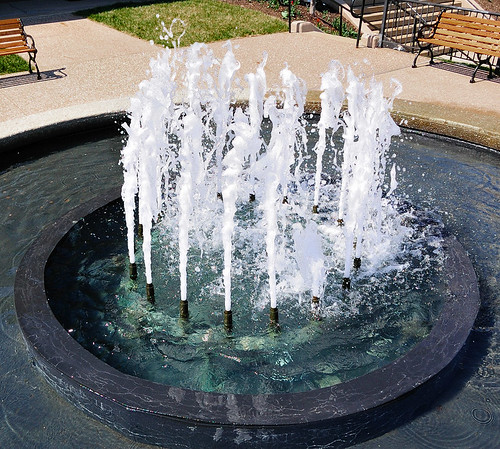
Kirkwood. I stood on the edge of this pool for the photo.
Fountains require a source of pressure to propel the water into the air. Nowadays, this pressure is provided by mechanical pumps, located either in the fountain itself, or at the municipal water utility. But fountains have existed from antiquity.
Ancient fountains required a water source that is higher in elevation than the spout, with gravity naturally providing the water pressure. First-century Rome had over 600 public water fountains, which were fed by a system of aqueducts bringing water from the hills. The water was directed into sealed lead pipes, and gravity provided enough pressure for even large monumental fountains. An original Roman fountain, the Fontana della Pigna, can be found at the Vatican.
For good primary documents on Rome's water supply, read Frontinius, who also wrote on the art of war, and the architectural book by Vitruvius.
Greek cities had a similar water supply for their fountains, although they used bronze pipes. They also used siphons: pipes could carry water over large hills and down valleys as long as they were well-sealed and with the source being higher than the exit.
Large public fountains were also found in Persia and Byzantium. The Muslim conquerers continued the tradition of fountains, and particularly developed symbolic water gardens.
Apparently, the Egyptians did not have spouting fountains in their cities. Their water supply was brought up from the Nile by water-wheels driven by the flow of the river itself, and the water pressure generated was small.
By the way, lead is a good metal for piping, as it is easy to work and is flexible enough to absorb some abrupt changes in pressure: its poisonous nature was known to the Romans, but that is mitigated by the patina that builds up over time. The Latin word for lead, plumbum, is where we get the English word ‘plumber’.
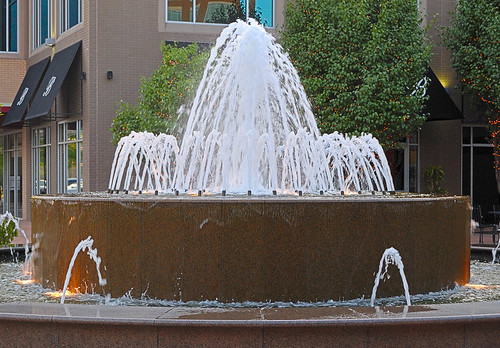
Creve Coeur.
The fountains of antiquity had the utilitarian purpose of providing water for drinking, watering animals, cleaning, bathing, and sanitation. However, the ancient fountains were by no means utilitarian in design, but rather were delightful to look upon. Our modern drinking fountains are utilitarian in design while decorative fountains retain the sense of visual delight. Our contemporary division between utility and aesthetics is problematic, and can even be deadly to our souls.
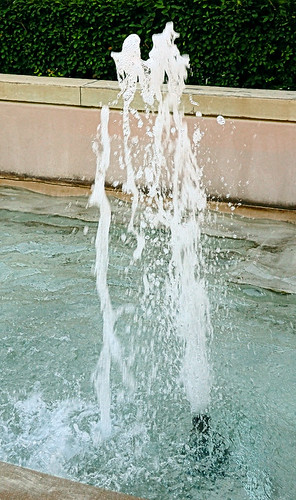
Near the previous fountain.
The use of fountains declined during the Middle Ages in the Latin West, although they did not completely disappear. With barbarian invasions and the plague — and a moral opposition to slave labor — large cities were unsustainable and mostly abandoned. People lived in smaller towns and monasteries, often located in more defensible locales, and any public water works were on a far more modest scale. Medieval fountains continued the ancient tradition of being decorative, often depicting Saints, scenes from Scripture, and the seasons.
Westport Plaza
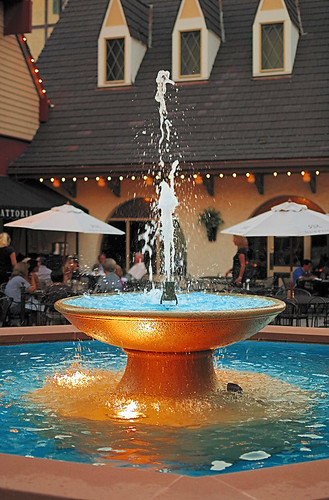
In a courtyard at Westport Plaza in Maryland Heights.
During the Avignon Papacy, Rome was reduced to little more than a collection of villages among ruins. When the Popes returned to Rome, they started rebuilding public works, including the aqueduct system that once fed the fountains. This return led to an interest in pagan antiquity which became the Renaissance. But this worldliness on the part of the higher ranks in the Church led to laxity and a greater desire for money, which was often used to produce neopagan monuments, opposition to which helped spark the Reformation and the wars of religion. The iconoclasm of the protesters eventually spilled out into the secular world, leading to our current divorce between aesthetics and utility, which even entered into the Church in the 20th century.
A divorce between the people and the political class continues down to our present day: the unity of society is lost. Rarely do contemporary public monumental works reflect the ideals of the people. I am reminded of the monumental fountain, originally titled “The Wedding of the Rivers” by Swedish sculptor Carl Milles, located in Aloe Plaza in Saint Louis. This pagan-themed work was put into place despite strong public opposition; the nearby sculpture “Twain” was — and is — perhaps the most-despised monument in the city, yet it remains. The artistic sentiments of the people are degraded and are becoming even more tasteless; this fact encourages the highly-educated curators of public art to diverge even further from the populace, who too often expresses disdain or hatred of the masses, which in turn drives the people even further away, increasing polarization.
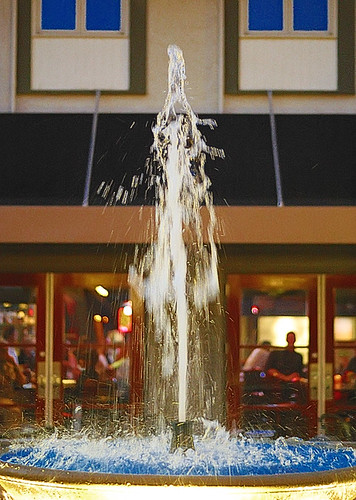
A closer view of the previous fountain's water jet.
While a sculptor may make an image of a venerable Saint or a despised tyrant, the fountainist is more directly working with nature herself. The subject of fountains is water, which has its own being apart from the works of the artist or architect who design the fountains. Designers can impose form on solid materials like stone or metal, but liquid water does not stay put. Water can be directed, but its flow can be only be shaped to a rough degree. Water follows its own rules, which cannot be ignored in a successful fountain design.
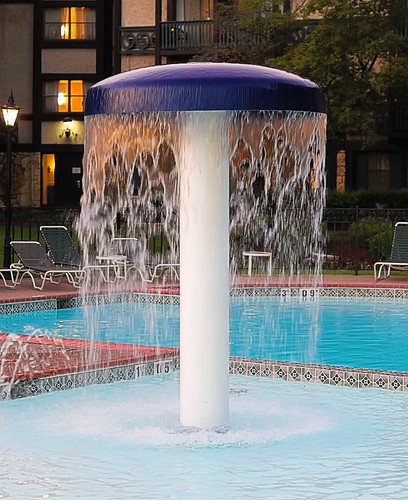
At Westport's pool. Fountains and swimming pools are natural allies.
Swimming pools are good for keeping cool on a hot day. It take a lot of heat to evaporate water, more than many other common liquids, and the water vapor is then taken away by the wind. Fountains in pools are both decorative and help increase this desired cooling: they are also fun to play in.
Large bodies of water also useful for warming in winter. As water freezes, it liberates heat. Unlike most other substances, frozen water is less dense than liquid water, and so ice forms on the top, and does not sink to the bottom. This prevents water bodies from freezing solid, and helps retain warmth in the water under the ice.
Fountains hereabouts are usually turned off in the wintertime, and thoroughly drained of water. As noted, water expands upon freezing, which exert enormous pressure that will burst anything it may be sealed in, including expensive water pumps and pipes. However, I have seen fountains still working in the wintertime: click here for a picture of one. If care is taken against freezing of the mechanisms, these frozen fountains can produce delightful and unpredictable ice sculptures.
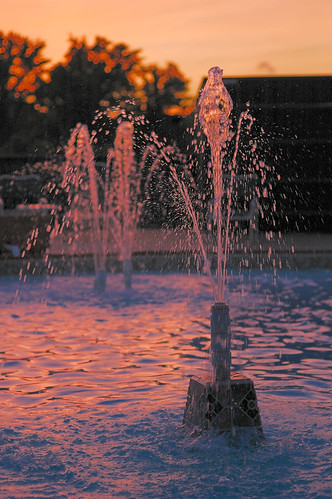
Also in the pool.
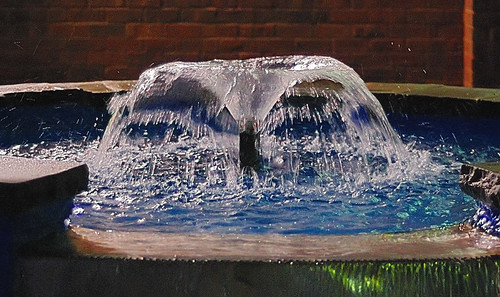
Human vision has a latency of somewhere between 1/15th and 1/30th of a second — a phenomenon that makes video possible — but this means that a camera's shutter speed ought to be within that range to give moving objects their visually expected blur. Longer shutter speeds give water a not-unattractive dreamy blurred look, while shorter speeds often make the water look like ice. As I didn't use a tripod on most of these shots, hand-holding the camera meant that I had to use shorter shutter speeds than are typically desirable
If you click on any photo, you are taken to Flickr; there you can click on “More properties” to discover the shutter speed used.
Our Lady of the Snows

Fountain in the Annunciation Garden at the National Shrine of Our Lady of the Snows in Belleville, Illinois. The water here is fittingly dyed a royal Marian blue. In the pool are bells which strike the hour.
The Sacrament of Baptism effects the spiritual cleansing of the soul, which is signified by the material cleansing of water. The essential life-giving property of water is a natural symbol of God's grace which sustains us spiritually. We ought not be surprised to find fountains, springs, and wells commonly mentioned in the Scripture and the Tradition of the Church, which often prefigure Baptism, or symbolize the source of Divine Grace.

Artificial waterfall, also at the Shrine.
Citygarden
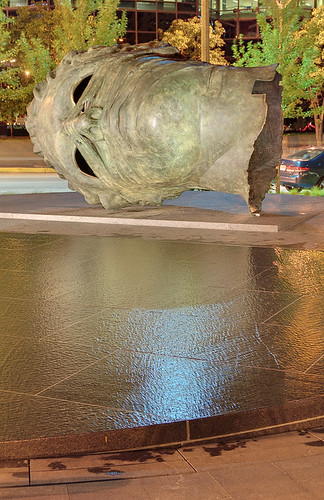
A sheet fountain.
The “Citygarden” is a new sculpture and fountain park found in downtown Saint Louis, Missouri. The bronze sculpture Eros Bound seems to be excessively horrific, especially in a park designed largely for children. The garden designers recognized this, and specifically placed the sculpture behind a scrim or sheet fountain which softens the effect. The water flows down a gentle slope, where it disappears into a narrow groove.
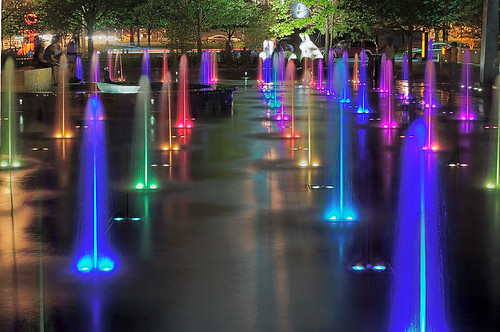
Children's splash fountain.
Quite admirable is this splash fountain, also found in the Citygarden. Water from the jets quickly flow back underground through narrow seams between the paving stones, preventing the water from pooling. Each jet of water is individually controlled by computer, as are the multicolored lights at their base. The sprays turn on at various heights and in many patterns. On a hot day, large numbers of children play here; and there were some running through the water as I was taking this photo, but they cannot be seen due to the long exposure time.
Controlled fountains have existed for a very long time, but they required people to manually open and close the water valves. Nowadays, programmable logic controllers can vary fountain displays, which are limited only by the imagination of the programmer — or as they are sometimes called — the choreographer of the fountain.
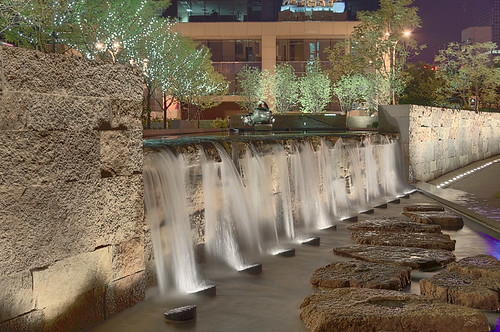
Waterfall at the Citygarden.
Central West End
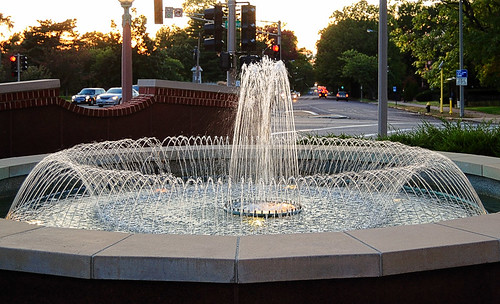
At the Chase Park Plaza, in the Central West End neighborhood; this building has another decorative fountain at its pool.
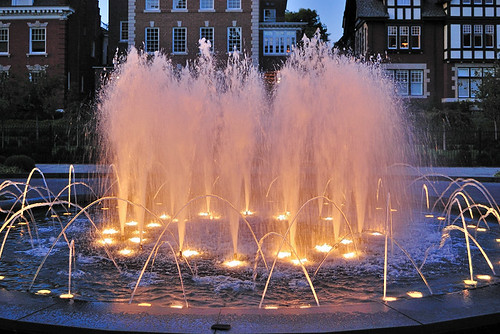
Centerpiece fountain in Maryland Plaza.
This fountain is fairly recent, and is choreographed to flow according to a soundtrack played on a number of adjacent speakers. Click here for my video of this fountain.
This is by the firm WET Design of California, which specializes in dynamically controlled fountains which emphasize the water itself rather than the sculptural elements usually found in fountain design.
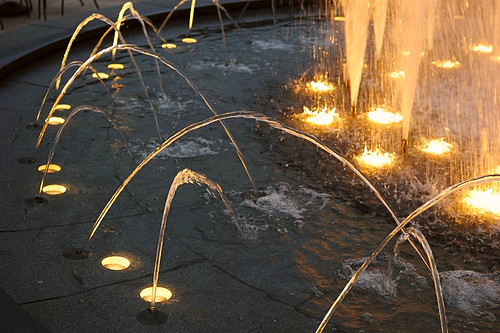
Close up of some of the fountain's laminar-flow water features. Eliminating the usually chaotic nature of flowing water takes a carefully-designed nozzle; although these streams seen here were somewhat buffeted by the wind. One of the founders of WET Design created a large-scale laminar flow nozzle while he was an undergraduate engineering student. Later he was hired by Disney and used his technology to create the famous Leapfrog fountain at Disney World in Florida. Laminar flow nozzles remain a common feature of the firm's works.
Clayton

One of the many fountains in downtown Clayton.
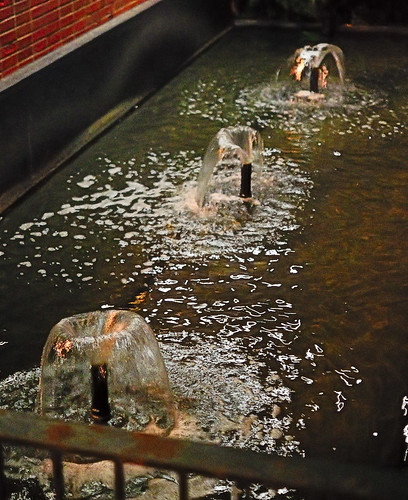
Forest Park
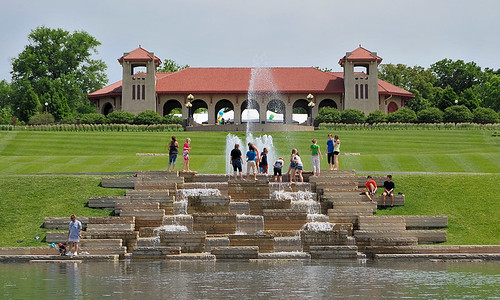
A fountain at the base of Government Hill, with the World's Fair Pavilion at the top.
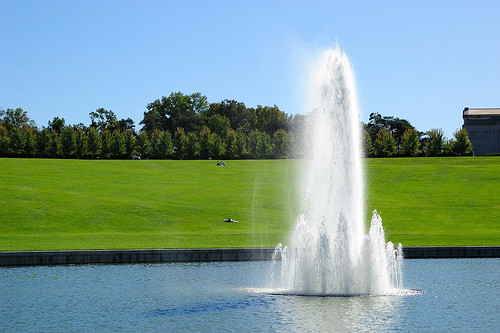
In the Grand Basin, with Art Hill in the background. This and many of the fountains shown here were designed by the local firm Hydro Dramatics.
Rustic fountains

A tiny domestic fountain in the Saint Louis Hills neighborhood, done in Japanese naturalistic fashion.
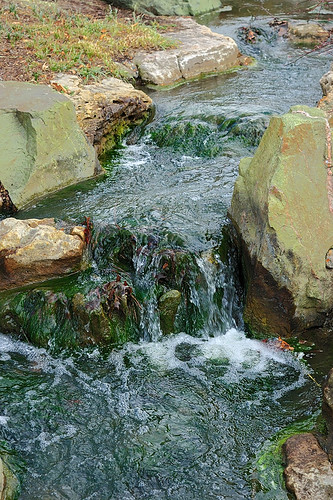
Artificial waterfall at the Japanese Garden at the Missouri Botanical Garden.
Water is a natural symbol of purity, and so it is also a symbol of purity in Japanese culture.
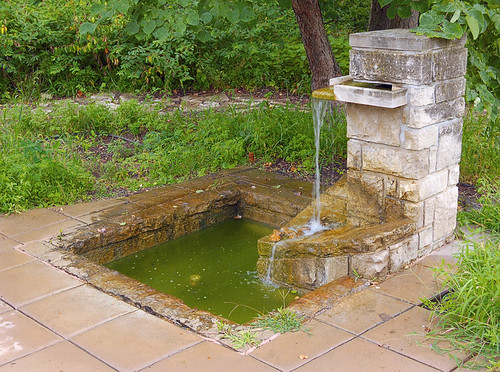
An appropriately rusticated fountain at Babler State Park, in Wildwood, Missouri.
All these photos were taken in 2009.


Lovely .. wish you could have a few weeks on the ocean coasts ...
ReplyDelete